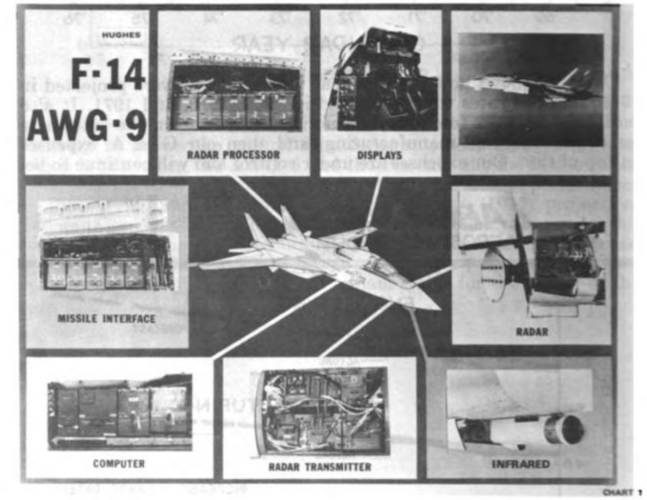pathology_doc
ACCESS: Top Secret
- Joined
- 6 June 2008
- Messages
- 1,433
- Reaction score
- 1,168
...when they seem to do basically the same job in the same airplane?
...when they seem to do basically the same job in the same airplane?
Now that's a very pertinent question (and answer too)
From my reading it seems that with the AWG-9 the radar (which was developed from the Hughes AN/ASG-18 of the XF-108) and the rest of the fire-control system (including the IRST & later TCS) were more completely integrated into a single functional unit than with previous radar & fire control systems - which led to there not actually being a separate designation for the radar (although the actual firing of weapons was done by the separate AWG-15 computer).Now that's a very pertinent question (and answer too)
Thinking about it, there seems to have been a philosophical divide between the USAF and USN here. USAF had AWGs on their aircraft (AWG-20 on the F-15C/D, for example) but the radar was the star and that the system that was discussed. For the Navy, the AWG was the star, at least in the 1970s. By the time APG-71 happened, they had come around to the USAF view and foregrounded the radar designation. (To confuse matters further, the F-14 actually had two AWGs: the AWG-9 and AWG-14.)
Aha! This explains a great deal.Now that's a very pertinent question (and answer too)
Thinking about it, there seems to have been a philosophical divide between the USAF and USN here. USAF had AWGs on their aircraft (AWG-20 on the F-15C/D, for example) but the radar was the star and that the system that was discussed. For the Navy, the AWG was the star, at least in the 1970s. By the time APG-71 happened, they had come around to the USAF view and foregrounded the radar designation. (To confuse matters further, the F-14 actually had two AWGs: the AWG-9 and AWG-14.)
From my reading it seems that with the AWG-9 the radar (which was developed from the Hughes AN/ASG-18 of the XF-108) and the rest of the fire-control system (including the IRST & later TCS) were more completely integrated into a single functional unit than with previous radar & fire control systems - which led to there not actually being a separate designation for the radar (although the actual firing of weapons was done by the separate AWG-15 computer).Now that's a very pertinent question (and answer too)
Thinking about it, there seems to have been a philosophical divide between the USAF and USN here. USAF had AWGs on their aircraft (AWG-20 on the F-15C/D, for example) but the radar was the star and that the system that was discussed. For the Navy, the AWG was the star, at least in the 1970s. By the time APG-71 happened, they had come around to the USAF view and foregrounded the radar designation. (To confuse matters further, the F-14 actually had two AWGs: the AWG-9 and AWG-14.)
Apparently, the APG-71 was actually a bit of a philosophical reversion, where the radar and fire-control were re-separated a bit - for example, the separate flight and weapons firing computers were combined in the two new AYK-14 mission computers, and all electronics, while linked together via the databus, were considered in a more individual and modular manner (planned for easier upgrading etc).

I just had this amusing thought - totally unrealistic, of course - of a Tomcat in a foreign land trying to find missiles to load. Someone digs out some old radar-guided AIM-4's and jury-rigs them up to the rails, and the pilots find to their amazement that someone at Hughes never removed redundant code from the system and the AWG-9 can work with the Falcons.developed from the Hughes AN/ASG-18 of the XF-108
It was more complex than that. Grumman re-architected the F-14 airborne missile control system in the 1980s with common off-the-shelf components coming from the F-18 and intended to being fitted to both the F-14D and A-6F. These WRAs were:Apparently, the APG-71 was actually a bit of a philosophical reversion, where the radar and fire-control were re-separated a bit - for example, the separate flight and weapons firing computers were combined in the two new AYK-14 mission computers, and all electronics, while linked together via the databus, were considered in a more individual and modular manner (planned for easier upgrading etc).
Dear Lord, imagine being shut out like that. I wouldn't be happy either!!!!At program onset, everyone was happy (except Hughes) with this approach.
It's almost like the J-40 disaster in reverse - instead of the airplanes sucking because the engine sucked, the equipment procurement was soured by the cancellation of the airframes!Manufacturers looked at an additional 600-800 shipsets of avionics to build (plus spares), the Navy looked at commonality with the F-18 and bench test equipment. This all fell apart as the A-6F was cancelled and only 55 F-14Ds and F-14D(R)s were built or converted.
